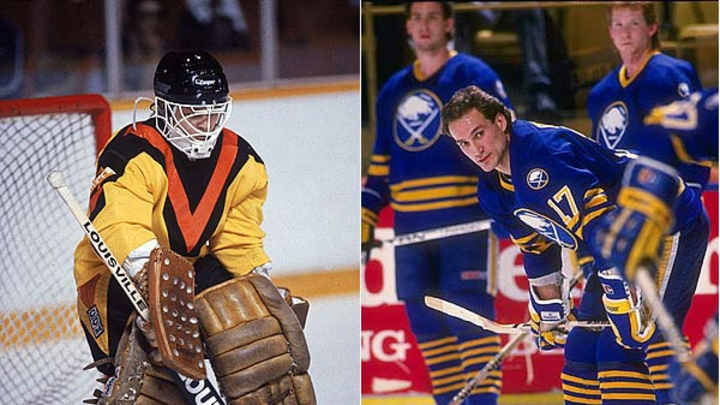Two minutes for booking: Canucks and Sabres celebrate 40 years in the NHL

Goalie Richard Brodeur, in the Canucks' distinctive sweater, and Sabres forward Mike Foligno, who had a distinctive way of stealing goals, are featured in two fine new books. (B. Bennett/R. Stewart/Getty Images)
By Stu Hackel
The Canucks are the NHL's hottest team, incredibly hot, with only one regulation loss in their last 22 games (18-1-3) and points gained in each of their last 17 (31 of a possible 34). They're first overall in the NHL and play the Rangers tonight (Thursday) in New York.
The Sabres are only modestly hot by comparison, grabbing seven of eight points to start the New Year, only to fall flat against the Flyers on Tuesday and surrender five straight goals after going up 2-0. Buffalo hosts the Hurricanes tonight and is 10 points out of the playoffs. Local columnist Jerry Sullivan of The Buffalo News is hoping the team's potential new owner takes control before the Feb. 28 trade deadline so he can "begin cleaning house and put to rest any notion that this ill-conceived team is a contender."
But while these two teams seem to be going in opposite directions, what they have in common is they are expansion cousins celebrating their 40th anniversaries this season with two excellent books that commemorate their colorful histories.
The books are quite different from the expected chronicling of the teams' sagas, and different from each other. Canucks At Forty, by Greg Douglas and Grant Kerr (John Wiley & Sons, 200 pages), with essays by seven other writers, reviews the team's story not by telling it chronologically like a standard history, but largely through fine photography and short biographical sketches of the legendary figures who have been associated with the franchise.
Along with the many portraits of notable players, you'll find coaches, owners, trainers, broadcasters and other team staff, like Babe Pratt, who never played or coached for Vancouver but served as the franchise's public face and goodwill ambassador from its earliest years until his death from a heart attack at a Canucks game in 1988.
It's a different way of getting at the subject. A reader may want to know, for example, about the team's great run to the Stanley Cup Final in 1982, but instead of a chapter on that, the topic comes into focus through the portraits of Harry Neale, Roger Neilson, Stan Smyl, Harold Snepsts, Richard Brodeur, Colin Campbell and Ron Delorme.
By contrast, Sabres At Forty is not the product of a commercial publisher, but the companion book to an exhibit of team photographs at the Albright-Knox Gallery in Buffalo that had a very successful run beginning in November and through the World Junior Championships, ending on Jan. 9. As such, it is far more photo-oriented than the Canucks book and these are many excellent images of the Sabres throughout their four decades.
The text is almost entirely anecdotes from those associated with the club's memorable moments, both large and small. Consequently, even more than the Canucks book, it's far from a standard historical account of the Sabres. John Tucker recalls that Mike Foligno's habitual jumps after scoring a goal probably stole a few calls. ("He would just be around the net and just jump and the ref would automatically give him the goal.") Clint Malarchuk discusses a prank he played on an unsuspecting traveler rushing through an airport (yelling "Stop that guy! He's got my wallet!"). Foligno relates how he'd see Gilbert Perreault jogging late at night in his neighborhood. ("He really didn't want anyone to see him. Low key and unassuming in how he prepared for a game.") It's a more personal approach that frequently reveals the humor of the players and the situations of their profession. It also provides the reader with a different dimension that would not be obtained otherwise.
Sabres at Forty also comes with a DVD with video of interviews that were the basis of the printed anecdotes, a terrific bonus. When former teammates speak about the tragic death of Hall of Fame defenseman Tim Horton, it's far more effective to hear their voices and see their faces than merely read their words on the printed page.
Both books touch on all the main figures, the Sabres' French Connection Line, Jim Schoenfeld, Pat LaFontaine, Dominik Hasek; the Canucks' Orland Kurtenbach, Glen Hanlon, Trevor Linden, Pavel Bure, Kirk MacLean and the Sedin twins. They and others have been the backbone of two outstanding NHL franchises that have never won the Stanley Cup -- although they have come close -- and their greatest playoff runs have helped define each club's image and cement bonds with its fans.
Helping forge those bonds were two Hall of Fame broadcasters. The late Ted Darling of the Sabres and Jim Robson of the Canucks provided the "voices" of their teams on radio and TV and each man is recognized as integral to his respective franchise's identity. In fact, Robson writes a very strong forward for the Canucks book, somehow capturing all 40 years in a few pages.
Two other announcers, Buffalo's Rick Jeanneret and Vancouver's Jim Hughson (who is now with CBC) are also included. Hughson contributed an essay on the Canucks' "West Coast Express" line of Markus Naslund, Brendan Morrison and Todd Bertuzzi.
Another franchise is not celebrating an anniversary, but the relatively new, authoritative and exhaustive Total Penguins: The Definitive Encyclopedia of the Pittsburgh Penguins by Rich Buker (Triumph Books, 720 pages) includes the stats of every player in Pens history as well as bios and photos of many.
I've always loved team history books. They are invaluable to fans of that particular team, and, really, any team. My hockey library is filled with them. These three are very unique, worthwhile additions.
